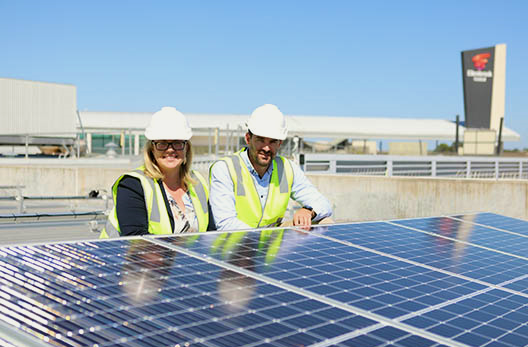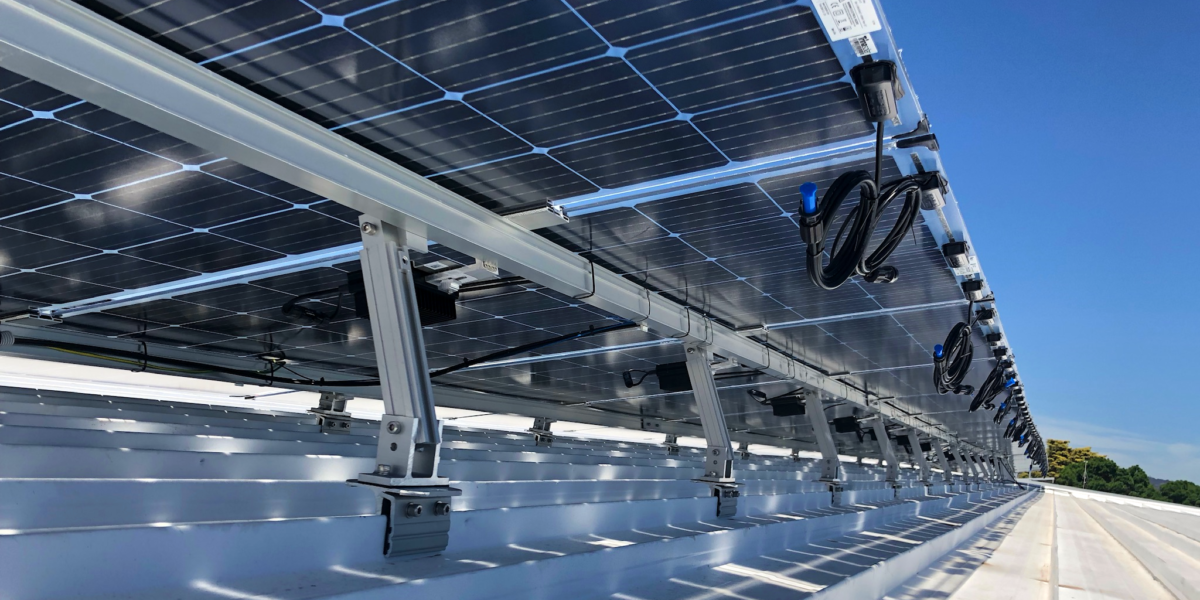Energy is the second-largest operating cost — after employees — of Vicinity Centres which has $26 billion in retail assets under management across 66 shopping centres in Australia. In December it energised its first bifacial panels on Kurralta Central Shopping Centre, to squeeze greater yields from its roof space, as part of a comprehensive plan to buffer the group against volatile energy prices. Preliminary results have spurred the company to expand its trial of bifacials across an entire carpark at Ellenbrook Central Shopping Centre in WA and integrated into other shopping-centre PV systems as appropriate.
Increased solar-panel output from the trial on Kurralta ranged from 6-8% to 16-18% depending on a variety of roof-surface coatings applied by Vicinity to maximise reflection onto the back of the panels. “It’s early days,” says Renae Sambrooks, General Manager of Energy and Commercial Management for Vicinity, “but results from Kurralta made us feel confident enough to install bifacials in three more centres.
“Over the next few months results of those trials will help us make decisions around our Stage 3 solar program,” she says.
Sambrooks is responsible for the development and delivery of Vicinity’s Integrated Energy Strategy and seeks to embed innovation and a future focus in every stage of the company’s ambitious plans. “As of today,” she told pv magazine on Friday, “we’ve produced 2.5MWh of clean energy from 13MW of installed capacity and we’re in the process of constructing the next 18 MW, which will be completed by the end of 2019.”
In late January this year, Forbes magazine reported, “So far the uptake of bifacial technology has been inhibited by the difficulty in predicting performance with a level of certainty.” It identified challenges to bifacials achieving greater market share (from 5 % share in 2015, they are predicted to achieve 40% by 2025) as including the need for more field testing.
Sambrooks’ testing program is comprehensive and will substantially contribute to the knowledge bank of bifacial benefits and limitations. Together with partners at Trina Solar Sambrooks’ team analysed studies on the advantages of bifacial panels in the market and concluded that they had been “trialled in a test-bed environment” and mounted in ideal conditions. “Mounting them 1.5 metres off the ground doesn’t work for a shopping centre roof, so our trial is about testing in live commercial conditions and collecting scientific data to calculate the commercial return.”
Says Govind Kant, Country Head of Trina operations across Australia, New Zealand and the Pacific, “Globally, I’ve not seen any other real-estate investment trust invest in solar in such a big and innovative way.” Trina switched out an entire production line to deliver on Sambrooks’ decision to install bifacial technology ahead of the pack.
Arrays of variation
At Kurralta, Vicinity set up four different arrays of Trina Duomax Twin PERC modules on tilt legs to maximise the advantage of reflected light hitting the back of the panel. Under each array the roof “treatment” is different, says Sambrooks. “On one of them we just washed the roof; on another we applied normal white paint, and then we have two different solar-cool paints under the last two.” Every bifacial array has its neighbouring standard flat-mounted single-sided array, and “optimisers collect panel-level data” for output comparison.
The top yield of 16-18% gain in output at Kurralta is probably conservative says Sambrooks, who explains that “the northwest-oriented arrays are designed to ensure they’re matched exactly to Kurralta’s shopping centre demand profile because we’re trying to reduce the spill and export to the network.”

Image: Vicinity Centres
In March, Vicinity energised another rooftop installation including trial arrays of bifacial panels, at Colonnades Shopping Centre, also in South Australia. Here, the system has a westerly orientation and is expected to produce a higher efficiency output because it has been tailored to Colonnades’ demand profile.
At Ellenbrook Central Shopping Centre in Western Australia, Vicinity will slightly increase the tilt of the 1 MW of bifacial modules it’s installing across a carpark roof, to allow more reflective energy to hit the back of the module.
“What I’m really interested in with the rest of the installations is having solid results for different parts of the country,” says Sambrooks.
Where extra expense makes sense
She adds that although bifacial panels are more expensive than conventional panels, and returns on investment may vary from location to location, “I can say that from now we are installing more bifacial panels; this is the future for us because we have finite roof space so we’re always looking for opportunities to work our asset harder.”
Her eye on the future includes recognition that as Australia moves towards a distributed-energy system, costs of energy in solar shoulder periods — before sunrise and after sunset — are likely to become more expensive. She says, “Bifacial panels offer a way to extend the generation pattern as the sun rises and sets.”
Battery storage will of course also change the game, and Sambrooks and her team didn’t wait for commercial viability to dawn before ordering Australia’s first large-scale storage battery for a retail environment. The 548 kW Sungrow-Samsung model is installed at Castle Plaza in South Australia, where Vicinity has also mounted 2 MW of solar on the rooftops, upgraded the behind-the-metre system and integrated all components into the building management system. The storage has primarily been used for peak load shaving and shifting, and system firming.
Although the battery won’t pay for itself for another 12 to 15 years, Sambrook says the experience her team has gained by testing it is invaluable: “We’ve learned a lot about what we can do with the next couple of batteries we’re putting in — we’ve come a lot further.”
An embedded culture of innovation
Under Sambrooks’ direction, the Vicinity Centres Integrated Energy Strategy never stops. The group is also trialling the potential of Trina Solar’s half-cell (continues to deliver output when partly shaded) and double-glass (claimed to offer up to 21% higher output over the life of the system) technologies; ClearVue’s transparent solar-generating glass; and blockchain for distributing energy to neighbouring communities, among other initiatives.
Some 70% of Australians live within 30 minutes of a Vicinity shopping centre, but Vicinity’s vision for mixed-use residential, retail and living precincts will bring people closer into the Vicinity community. Clean, cheaper-energy advantages are planned as part of the residential-tenant offering.
Retailers in solar-enabled Vicinity properties already benefit from between 5% and 10% savings on the market electricity rate, a discount which still allows the retail giant to offset the upfront cost of its energy programs and continue to invest.
Sambrooks says the company’s return on its current solar program is around 12% IRR, “which our business is quite happy with”.
As her team prepares to incorporate its learnings into Stage 3 of its solar program — to be announced at the end of this year — Sambrook says that formulating Vicinity’s Integrated Energy Strategy in 2017 was vital: “Our vision was to create intelligent energy destinations. We’re not just whacking solar panels on roofs. It’s a long-term investment and we’re always thinking how we can sweat the solar installations and all our other energy initiatives to make a return.”
This content is protected by copyright and may not be reused. If you want to cooperate with us and would like to reuse some of our content, please contact: editors@pv-magazine.com.









2 comments
By submitting this form you agree to pv magazine using your data for the purposes of publishing your comment.
Your personal data will only be disclosed or otherwise transmitted to third parties for the purposes of spam filtering or if this is necessary for technical maintenance of the website. Any other transfer to third parties will not take place unless this is justified on the basis of applicable data protection regulations or if pv magazine is legally obliged to do so.
You may revoke this consent at any time with effect for the future, in which case your personal data will be deleted immediately. Otherwise, your data will be deleted if pv magazine has processed your request or the purpose of data storage is fulfilled.
Further information on data privacy can be found in our Data Protection Policy.